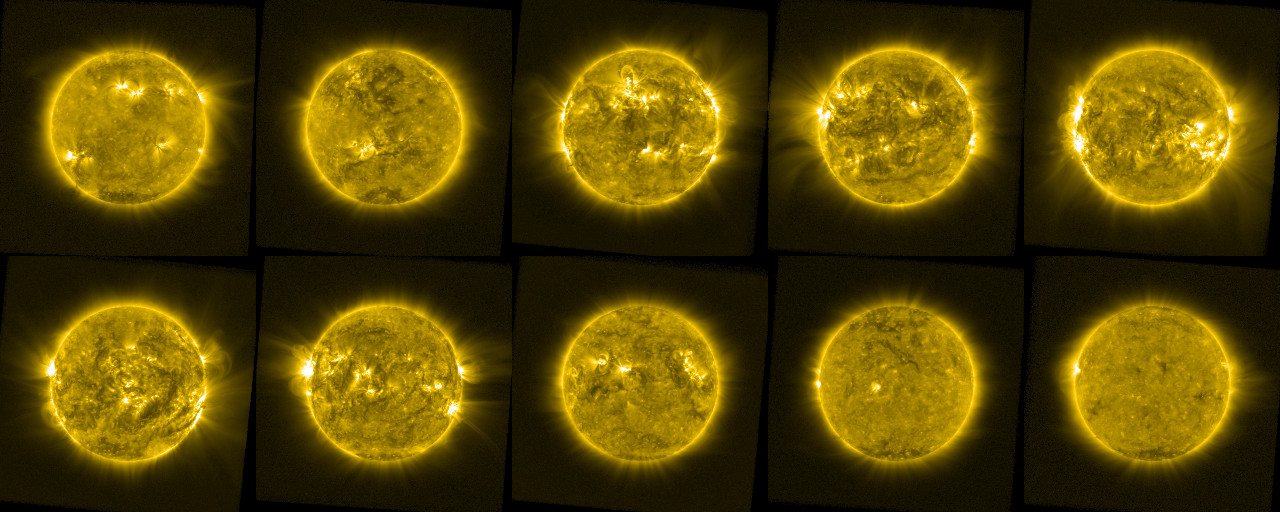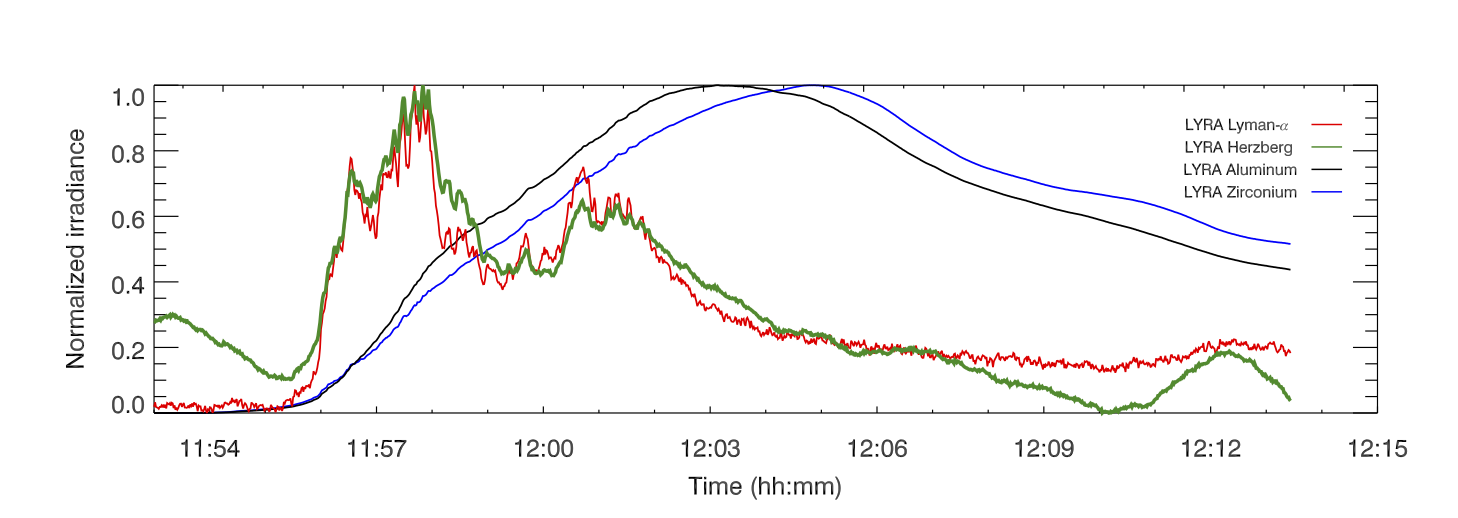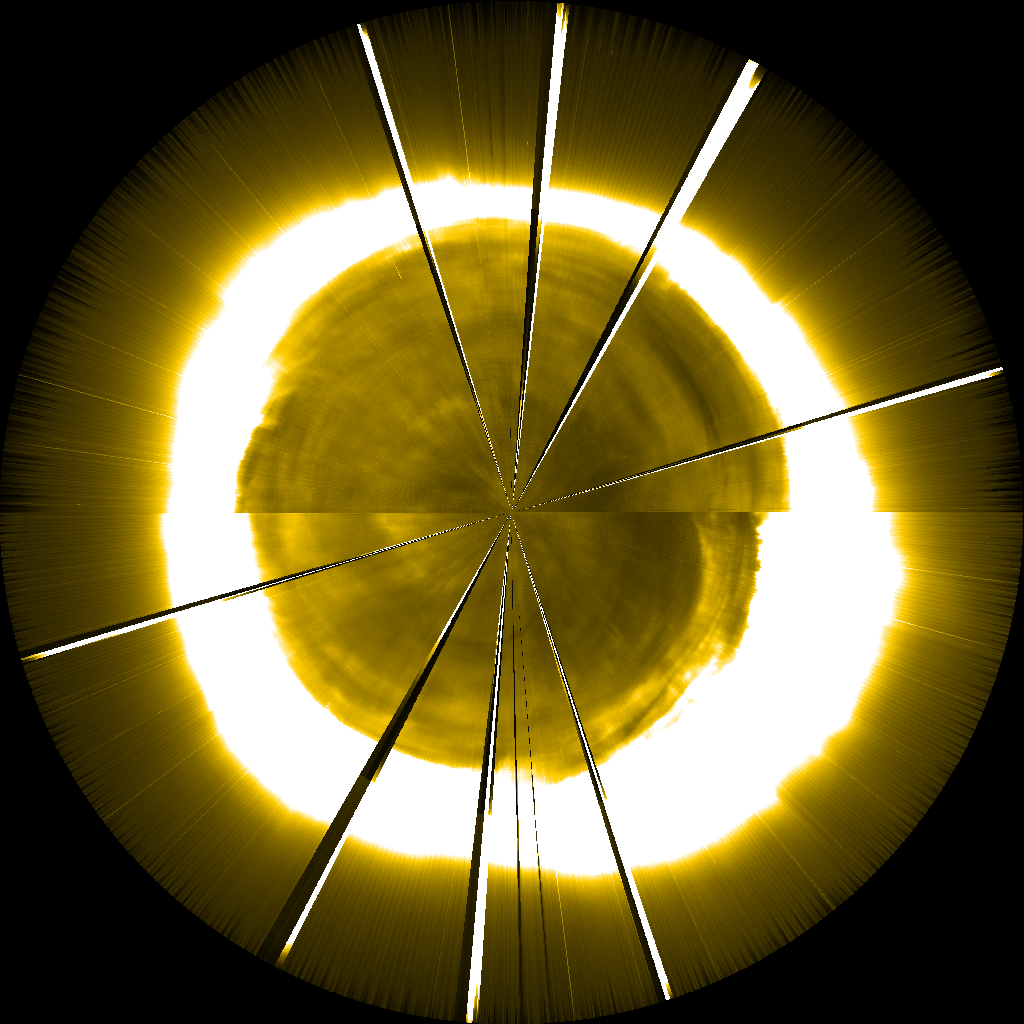Main menu
You are here
10 Years of Observations

Ten years ago, on November 2, 2009, the PROBA2 ESA micro-satellite was launched on a Rockot launcher from the Russian launch base Plesetsk, into a sun-synchronous orbit (dawn/dusk polar orbit). More details of the launch and orbit can be found here.
PROBA2 was launched as the second of the European Space Agency's (ESA) fleet of PROBA satellites, which is part of ESA's in-orbit Technology Demonstration programme. PROBA2 hosts 17 new technological developments including two main solar instruments (SWAP and LYRA) designed for studying all events on the Sun that might have implications on the solar-terrestrial connection, both through imaging (SWAP) as well as through irradiance measurements (LYRA). More details on the technology developments can be found here.

Figure 1. An Artists impression of the PROBA2 separation from it's launch vehicle, image courtesy of ESA.
SWAP provides images of the solar corona filtered at a wavelength around 17.4 nm, a bandpass (filter) that corresponds to a temperature of roughly 1 million degrees, allowing us to see the hot solar atmosphere while filtering out the relatively cooler solar surface. SWAP has a cadence (rate at which images are taken) of 1 image every 2 minutes, and observes an exceptionally wide field-of-view (FOV) of 54 arcmin, allowing it to see more structures around the edge of the Sun. SWAP was designed as a compact instrument, with a new off-axis optical design, radiation resistant, and uses a new CMOS-APS detector. SWAP's large FOV was unique in the field of EUV imagers providing the first continuous observations of the extended solar atmosphere.
Figure 2 shows SWAP images from several days spread throughout the mission, the top row shows images from 2010-Feb-20, 2011-Feb-01, 2012-Jan-20, 2013-Feb-05 and, 2014-Jan-28 respectively. The bottom row shows images from, 2015-Jan-19, 2016-Feb-05, 2017-Jan-22, 2018-Feb-02 and, 2019-Feb-01 respectively. The images are processed to show the extended solar atmosphere (the bit around the edge). Observing the structured nature of the extended solar atmosphere is one of the most important observations made by SWAP.
It has long been known that the Sun undergoes an 11-year activity cycle, where solar activity, such as the magnitude and number of flares and coronal mass ejections, fluctuates. The images in Figure 2 reflect this variability through the changing the number of coronal holes (the dark regions) and the number of active regions (the bright structures), which are often the source of the more dramatic solar activity. In 2010 the Sun was reaching the end of its solar minimum phase, its activity increased, peaking at solar maximum around 2014, before once again declining towards solar minimum, which we're currently experiencing (at time of writing). More information about how SWAP observes solar rotation, the solar activity cycle and its different phases can be found here.


Figure 3. LYRA light curves of the 6th of September 2017 X9.3 flare.
Space Weather. SWAP and LYRA were originally designed for studying the Sun and energetic events, such as solar flares, coronal holes and CMEs, that might have implications on the solar-terrestrial connection. Naturally, the observations have become an integral part of several solar-monitoring space weather forecasting centers, and as a consequence PROBA2 has been supported by ESA's Space Situational Awareness (SSA) program since 2013. Several tools have also been developed to utilize the data and track the location of events including the PROBA2 SSA services page, used to track flares and active regions on the Sun, and SWAP/LYRA data products served through the Solar Weather Expert Service Centre (S-ESC) page. Figure 2 above shows several images of the Sun. Active regions (the bright structures) and coronal holes (the dark regions) can clearly be seen in these static images, both of which can have implications for space weather at the Earth. SWAP and LYRA are also monitoring more transient, energetic and eruptive, phenomena such as flares and CMEs, Figure 4 below shows SWAPs ability to track eruptions into the extended solar atmosphere. SWAP and LYRA will continue to monitor such structures providing a warning for potential space-weather events. PROBA2 mission support is foreseen to be continued by ESA’s Space Safety Programme starting in 2020.

Figure 4. A flare (top left panel) and eruption observed by SWAP on 2017-Apr-1. The eruption was traced to over 1-Solar Radii, highlighted by the dashed line.
Vital Statistics. PROBA2 was launched under the ESA Technology, Engineering and Quality Directorate (D/TEC). After launch, the ESA Science Directorate (D/SCI) supported the scientific exploitation of the PROBA2 science instruments and the Belgian PI-teams were supported by PRODEX. Due to PROBA2's solar monitoring capabilities, it has been supported by ESA's SSE-SSA program in recent years.
Since its launch, PROBA2 has:
- been in orbit 3653 days.
- Orbited the Earth ~53,000 times.
- Produced ~30,000 LYRA data files.
- Produced ~2,090,000 SWAP images.
- Passed our ground stations in Redu, Belgium and Svalbard, Norway (Arctic) 32,453 times.
- Helped produce over 100 peer-reviewed papers, the full list can be seen here.
The PROBA2 Science Centre at the Royal Observatory of Belgium has had the honour of running a guest investigator program. The program has been hugely successful welcoming scientists from across the planet, giving them the opportunity to help operate and understand the instruments on PROBA2, with a view to running dedicated scientific campaigns. The program has had 8 calls from 2010 to 2018, and welcomed 64 teams, 81 team members from 16 countries.

Figure 5. The ESA Redu station, which tracks, communicates with, and supports the PROBA-series of satellites.
The next generation of CMOS detectors, successors to SWAP detector, fed directly into the development of the EUI EUV detectors on Solar Orbiter, ESA's new flagship solar mission, to be launched in 2020. The ESA is also planning a dedicated space weather monitor, to be launched to the L5 Lagrange point (to the side of the Sun from the perspective of the Earth). It's anticipated that the Lagrange mission will host an EUV imager using the same detectors as EUI, producing an exceptionally large field-of-view EUV images. Thiw will allow for the tracking of solar eruptions close to the Sun towards the Earth, providing an early warning to potentially damaging solar events.







